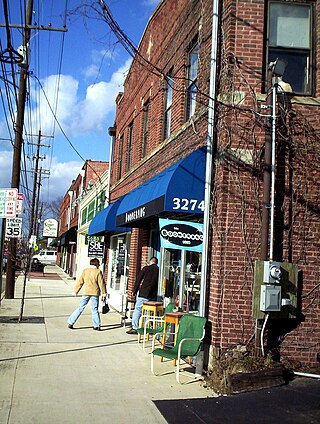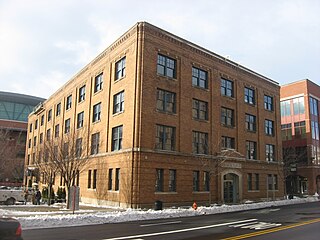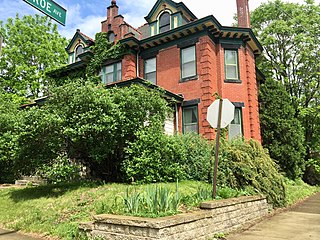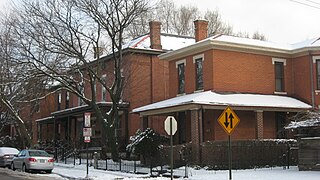
Clintonville is a suburban neighborhood in north-central Columbus, Ohio, United States with around 30,000 residents. Its borders, associated with the Clintonville Area Commission, are the Olentangy River on the west, Glen Echo Creek to the south, a set of railroad tracks to the east, and on the north by the Worthington city limits.
The University District, is a 2.8-square-mile (7.3 km2) area located 2 miles (3.2 km) north of Downtown Columbus, Ohio that is home to the main campus of Ohio State University, the Battelle Institute, and Wexner Medical Center. It is generally accepted as the area bounded to the north by Clintonville at Glen Echo Ravine; to the south by the Short North at 5th Avenue; to the west by the Olentangy River and to east by the Conrail railroad tracks. Points of interest include, but are not limited to, the Ohio Stadium and Old North Columbus. The district is Columbus' most densely populated area and contains more than 650 businesses, human service agencies, churches, and schools. University District businesses include boutiques, mixed retail, several tattoo studios, the Gateway Film Center, and a diverse range of restaurants and bars.
Columbus, the state capital and Ohio's largest city, has numerous neighborhoods within its city limits. Neighborhood names and boundaries are not officially defined. They may vary or change from time to time due to demographic and economic variables.

Glen Echo is a neighborhood located in the far northern part of the University District in Columbus, Ohio. The area was listed on the National Register of Historic Places in 1997. The name Glen Echo refers to Glen Echo Ravine, which runs along the northern edge of the neighborhood. Principal streets in the area are Glen Echo Drive, Summit Street, Glenmawr Avenue, North Fourth Street, Arcadia, Cliffside Drive, and more. One street, Parkview Drive, was platted in the ravine basin, but was later abandoned.

The Main Street–College Street Historic District encompasses a historically fashionable residential area of Burlington, Vermont. Principally located along Main and College Streets between South Winooski and South Williams Streets, the area was one of the city's most exclusive residential areas from the early 19th century to the early 20th century, and includes a diversity of high quality architecture from that period. It was listed on the National Register of Historic Places in 1988.

The Richard Berry Jr. House is a historic house in the Clintonville neighborhood of Columbus, Ohio, United States. The house was listed on the National Register of Historic Places in 2005 and the Columbus Register of Historic Properties in 2006. The house is also a part of the East North Broadway Historic District, listed on the National Register in 2010. It is a well-preserved example of early 20th century Colonial Revival houses. It was built in 1926 and designed by Columbus architect Ray Sims.

The Krumm House is a historic building in the Brewery District neighborhood of Columbus, Ohio. It was listed on the National Register of Historic Places and Columbus Register of Historic Properties in 1982. The brick house was built c. 1885. The building was home to Alexander W. Krumm, the Columbus City Solicitor from 1878 to 1883. The property is also one of few remaining late 19th century houses on South High Street.

The Ohio Moline Plow Building is a historic building in the Arena District in Downtown Columbus, Ohio. It was listed on the National Register of Historic Places in 1999. The building was built in 1913 as an office, warehouse, and sales space for the Ohio Moline Plow Company, part of the Moline Plow Company based in Illinois. It is located in a former warehouse district, which once held numerous buildings of similar size, scale, and materials. In the late 20th century, most of the buildings were demolished. The building is also significant for its design integrity and materials, with original patterned brickwork and stone trim, and glass and wood office partitioning.

The Municipal Light Plant is a historic building in the Arena District of Downtown Columbus, Ohio. It was listed on the National Register of Historic Places in 2015. The structure includes an early 20th century Romanesque Revival building and a mid-20th century Art Deco addition.

The High and Gay Streets Historic District is a historic district in Downtown Columbus, Ohio. The site was listed on the National Register of Historic Places in 2014.

The Columbus Near East Side District is a historic district in the Near East Side of Columbus, Ohio. The site was listed on the National Register of Historic Places in 1978. A portion of the district, the Bryden Road District, was added to the Columbus Register of Historic Properties in 1990. An addition, the Columbus Near East Side Historic District-Parsons Avenue, was added to the register in 1983.

The Old Beechwold Historic District is a neighborhood and historic district in Clintonville, Columbus, Ohio. The site was listed on the Columbus Register of Historic Properties in 1985 and the National Register of Historic Places in 1987. The district is significant for its architecture, landscape architecture, and community planning. The houses are of the early 20th century, using stone, brick, and stucco.

The Gilbert H. Hamilton House is a historic building in the Glen Echo neighborhood of Columbus, Ohio. It was listed on the National Register of Historic Places in 1992 and the Columbus Register of Historic Properties in 2018. The house, completed in 1927, overlooks the Glen Echo Ravine. It was built for Gilbert H. and Caroline J. Hamilton; the family lived there until 1952.

The Old North End Historic District is a historic district in the Italian Village neighborhood of Columbus, Ohio. It was listed on the National Register of Historic Places in 1996. A boundary increase was approved to the register in 1999. District boundaries overlap with the city's Italian Village Historic District.

The Elam Drake House was a historic house in Columbus, Ohio, United States. The house was listed on the National Register of Historic Places in 1978. The two-story brick building was constructed in 1856. It featured a one-story north end, built in 1856, with a 1.5-story addition to the south, built between 1856 and 1857. The farmstead, including a barn, summer kitchen, and smoke house, was built by a Elam Drake, a former brick layer and plasterer who constructed many of the city's earliest buildings and later retired to take up farming in 1856. The site stood as an example of farmstead structures typical of the 19th century.

The Garfield-Broad Apartments is a historic building in the Olde Towne East neighborhood of Columbus, Ohio. It was built in 1929 and added to the National Register of Historic Places in 1986.

The Soloman Levy House is a historic house in Columbus, Ohio, United States. The house was built c. 1910-11 and was listed on the National Register of Historic Places in 1986. The Soloman Levy House was built at a time when East Broad Street was a tree-lined avenue featuring the most ornate houses in Columbus; the house reflects the character of the area at the time. The building is also part of the 18th & E. Broad Historic District on the Columbus Register of Historic Properties, added to the register in 1988.

The Heyne-Zimmerman House is a historic house in Columbus, Ohio, United States. The house was built c. 1912 and was listed on the National Register of Historic Places in 1987. The Heyne-Zimmerman House was built at a time when East Broad Street was a tree-lined avenue featuring the most ornate houses in Columbus; the house reflects the character of the area at the time. The building is also part of the 18th & E. Broad Historic District on the Columbus Register of Historic Properties, added to the register in 1988.

The Shedd-Dunn House is a historic house in Columbus, Ohio, United States. The house was built in 1888 and was listed on the National Register of Historic Places in 1986. The Shedd-Dunn House was built at a time when East Broad Street was a tree-lined avenue featuring the most ornate houses in Columbus; the house reflects the character of the area at the time. The building is also part of the 18th & E. Broad Historic District on the Columbus Register of Historic Properties, added to the register in 1988.

The Frederick A. Miller House, or Broad Gables, is a historic house in the Wolfe Park neighborhood of Columbus, Ohio, United States. The house was listed on the National Register of Historic Places in 1985. It is a well-preserved example of early 20th century Tudor Revival houses. It was built in 1915 and designed by Columbus firm Richards, McCarty & Bulford in the Tudor Revival style.




















